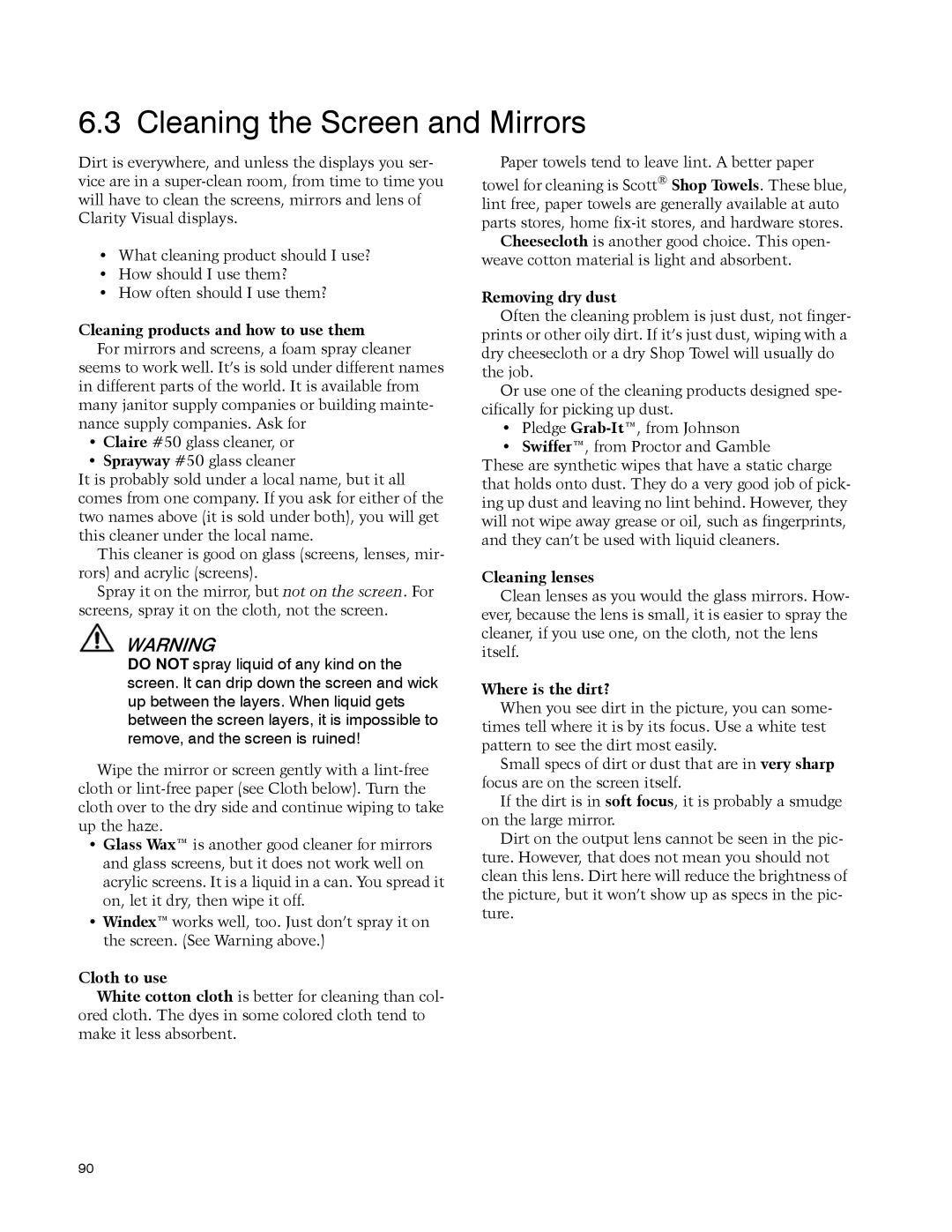6.3 Cleaning the Screen and Mirrors
Dirt is everywhere, and unless the displays you ser- vice are in a
•What cleaning product should I use?
•How should I use them?
•How often should I use them?
Cleaning products and how to use them
For mirrors and screens, a foam spray cleaner seems to work well. It’s is sold under different names in different parts of the world. It is available from many janitor supply companies or building mainte- nance supply companies. Ask for
•Claire #50 glass cleaner, or
•Sprayway #50 glass cleaner
It is probably sold under a local name, but it all comes from one company. If you ask for either of the two names above (it is sold under both), you will get this cleaner under the local name.
This cleaner is good on glass (screens, lenses, mir- rors) and acrylic (screens).
Spray it on the mirror, but not on the screen. For screens, spray it on the cloth, not the screen.
WARNING
DO NOT spray liquid of any kind on the screen. It can drip down the screen and wick up between the layers. When liquid gets between the screen layers, it is impossible to remove, and the screen is ruined!
Wipe the mirror or screen gently with a
•Glass Wax™ is another good cleaner for mirrors and glass screens, but it does not work well on acrylic screens. It is a liquid in a can. You spread it on, let it dry, then wipe it off.
•Windex™ works well, too. Just don’t spray it on the screen. (See Warning above.)
Cloth to use
White cotton cloth is better for cleaning than col- ored cloth. The dyes in some colored cloth tend to make it less absorbent.
Paper towels tend to leave lint. A better paper
towel for cleaning is Scott® Shop Towels. These blue, lint free, paper towels are generally available at auto parts stores, home
Cheesecloth is another good choice. This open- weave cotton material is light and absorbent.
Removing dry dust
Often the cleaning problem is just dust, not finger- prints or other oily dirt. If it’s just dust, wiping with a dry cheesecloth or a dry Shop Towel will usually do the job.
Or use one of the cleaning products designed spe- cifically for picking up dust.
•Pledge
•Swiffer™, from Proctor and Gamble
These are synthetic wipes that have a static charge that holds onto dust. They do a very good job of pick- ing up dust and leaving no lint behind. However, they will not wipe away grease or oil, such as fingerprints, and they can’t be used with liquid cleaners.
Cleaning lenses
Clean lenses as you would the glass mirrors. How- ever, because the lens is small, it is easier to spray the cleaner, if you use one, on the cloth, not the lens itself.
Where is the dirt?
When you see dirt in the picture, you can some- times tell where it is by its focus. Use a white test pattern to see the dirt most easily.
Small specs of dirt or dust that are in very sharp focus are on the screen itself.
If the dirt is in soft focus, it is probably a smudge on the large mirror.
Dirt on the output lens cannot be seen in the pic- ture. However, that does not mean you should not clean this lens. Dirt here will reduce the brightness of the picture, but it won’t show up as specs in the pic- ture.
90
